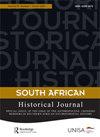历史纪念日
IF 1
3区 历史学
Q1 HISTORY
引用次数: 0
摘要
点击增大图片尺寸点击减小图片尺寸注1 James Simpson的硕士论文是最全面的论述。参见J. Simpson,“Boipatong:大屠杀的政治与南非转型”(硕士论文,开普敦大学,2009年)。加里·基诺奇(Gary Kynoch)最近的专著没有深入研究大屠杀及其历史的细节。参见G. Kynoch,乡镇暴力与种族隔离的结束:珊瑚礁战争(Woodbridge: James Currey, 2018)这些攻击的证据是广泛的。例如,见威特沃特兰德大学,历史论文研究档案馆(以下简称HPRA),戈德斯通委员会,博伊帕通大屠杀记录,AK2672(以下简称AK2672) F.1.2,报告:瓦尔三角的暴力事件,1990年7月至1992年7月。其中最臭名昭著的事件是1991年1月12日的楠加伦贝守夜大屠杀。P. Pigou,《种族隔离国家与暴力:真相与和解委员会发现了什么?》《政治》,28,2 (2001),207-233;S. Ellis,“南非第三势力的历史意义”,南部非洲研究杂志,24,2 (1998),261-299.4 HPRA, AK2672, B12.6.003, Klaas mathope的声明。5 O ' malley Archive,“Response - Piers Pigou from Boipatong”,2000年8月16日,https://omalley.nelsonmandela.org/index.php/site/q/03lv02039/04lv02133/05lv02139/06lv02148.htm, 2023.6 5月15日访问,同上;D. Beresford,“高级调查员抨击TRC”,邮件,2023年5月15日获取。例如,参见HPRA,独立调查委员会(IBI)记录,AG2543(以下简称AG2543), 2.2.7, ibir 1990年9月报告;1993年5月期间的HPRA, AG2543, IBIIR报告。Simpson主要侧重于大屠杀的政治影响以及非洲人国民大会(ANC)通过指控第三方势力参与而获得的政治影响力。参见辛普森的《Boipatong》南非历史档案馆(以下简称SAHA),信息自由计划收藏,AL2878(以下简称AL2878), B01.5.4.03, E. A. de Kock, Aansoek和大赦,AM0066/96, 1997年5月10日。10 O ' malley档案馆,“回应-来自博伊帕通的皮尔斯·皮古”SAHA, AL2878, B01.5.75.04.10,第29节调查记录Hpra, ak2672, f2.1。,材料:佩德罗·皮恩斯;SAHA, AL2872, B01.5.75.04.22,第29节不公开听证会1997年7月29日。关于极右翼与警察联系的重要性,见D. W. Potgieter,可怕的:震撼南非的罪行和罪犯(开普敦:斑马出版社,2015),35-59.13 Potgieter,可怕的,52.14 HPRA, AK2672, F1.2,瓦尔三角的暴力,1990年7月- 1992年7月15 Kheswa的成员身份得到了WPM领导人Koos Vermeulen的确认,尽管Vermeulen后来撤回了他的声明我从Vanessa Barolsky那里借用了这个框架,她分析了《Kathorus》中暴力的“过度”和“越界”特征。参见V. Barolsky,从暴力中过渡:从Kathorus的快照(约翰内斯堡:暴力与和解研究中心,2005)。作者简介franziska Rueedi是苏黎世大学的高级讲师和研究员。她的研究主要集中在20世纪80年代和90年代南非的民众抗议、集体暴力和冲突,以及非殖民化时代的跨国网络。她是《1984年瓦尔起义和南非争取自由的斗争》一书的作者。她正在撰写她的第二本书,主题是南非向民主过渡期间暴力与和平的作用。本文章由计算机程序翻译,如有差异,请以英文原文为准。
Historical Anniversaries
Click to increase image sizeClick to decrease image size Notes1 James Simpson’s MA thesis is the most comprehensive account. See J. Simpson, ‘Boipatong: The Politics of a Massacre and the South African Transition’ (MA thesis, University of Cape Town, 2009). Gary Kynoch’s recent monograph does not delve into the details of the massacre and its history. See G. Kynoch, Township Violence and the End of Apartheid: War on the Reef (Woodbridge: James Currey, 2018).2 The evidence of these attacks is extensive. See, for example, University of the Witwatersrand, Historical Papers Research Archive, (hereafter HPRA), Goldstone Commission, Boipatong Massacre records, AK2672 (hereafter AK2672) F.1.2, Report: Violence in the Vaal Triangle, July 1990–July 1992. Amongst the most notorious incidents is the Nangalembe night vigil massacre of 12 January 1991.3 P. Pigou, ‘The Apartheid State and Violence: What Has the Truth and Reconciliation Commission Found?’, Politikon, 28, 2 (2001), 207–233; S. Ellis, ‘The Historical Significance of South Africa’s Third Force’, Journal of Southern African Studies, 24, 2 (1998), 261–299.4 HPRA, AK2672, B12.6.003, Statement of Klaas Mathope.5 O’Malley Archive, ‘Response – Piers Pigou from Boipatong’, 16 August 2000, https://omalley.nelsonmandela.org/index.php/site/q/03lv02039/04lv02133/05lv02139/06lv02148.htm, accessed 15 May 2023.6 Ibid.; D. Beresford, ‘Top Investigator Slams the TRC’, Mail, accessed 15 May 2023.7 See, for example, HPRA, Independent Board of Inquiry (IBI) records, AG2543 (hereafter AG2543), 2.2.7, IBIIR Report for the period September 1990; HPRA, AG2543, IBIIR Report for the period of May 1991.8 Simpson primarily focuses on the political implications of the massacre and the political leverage the African National Congress (ANC) gained through allegations of third force involvement. See Simpson, ‘Boipatong’.9 South African History Archive (hereafter SAHA), The Freedom of Information Programme collection, AL2878 (hereafter AL2878), B01.5.4.03, E. A. de Kock, Aansoek om amnestie, AM0066/96, 10 May 1997.10 O’Malley Archive, ‘Response – Piers Pigou from Boipatong’.11 SAHA, AL2878, B01.5.75.04.10, Section 29 inquiry transcript.12 HPRA, AK2672, F2.1., Material re Pedro Peens; SAHA, AL2872, B01.5.75.04.22, Section 29 in-camera hearing 29 July 1997. On the significance of ultra-right connections to the police, see D. W. Potgieter, Gruesome: The Crimes and Criminals that Shook South Africa (Cape Town: Zebra Press, 2015), 35–59.13 Potgieter, Gruesome, 52.14 HPRA, AK2672, F1.2, Violence in the Vaal Triangle, July 1990–July 1992.15 Kheswa’s membership was confirmed by WPM leader Koos Vermeulen, though Vermeulen later retracted his statement.16 I borrow this framing from Vanessa Barolsky, who has analysed the ‘excessive’ and ‘transgressive’ character of violence in Kathorus. See V. Barolsky, Transitioning Out of Violence: Snapshots from Kathorus (Johannesburg: Centre for the Study of Violence and Reconciliation, 2005).Additional informationNotes on contributorsFranziska RueediFranziska Rueedi is a senior lecturer and researcher the University of Zürich. Her research focuses on popular protest, collective violence and conflict during the 1980s and 1990s in South Africa, as well as transnational networks during the era of decolonization. She is the author of The Vaal Uprising of 1984 & the Struggle for Freedom in South Africa. She is working on her second book on the role of violence and peace during South Africa's transition to democracy.
求助全文
通过发布文献求助,成功后即可免费获取论文全文。
去求助
来源期刊

South African Historical Journal
Multiple-
CiteScore
0.70
自引率
0.00%
发文量
37
期刊介绍:
Over the past 40 years, the South African Historical Journal has become renowned and internationally regarded as a premier history journal published in South Africa, promoting significant historical scholarship on the country as well as the southern African region. The journal, which is linked to the Southern African Historical Society, has provided a high-quality medium for original thinking about South African history and has thus shaped - and continues to contribute towards defining - the historiography of the region.
 求助内容:
求助内容: 应助结果提醒方式:
应助结果提醒方式:


